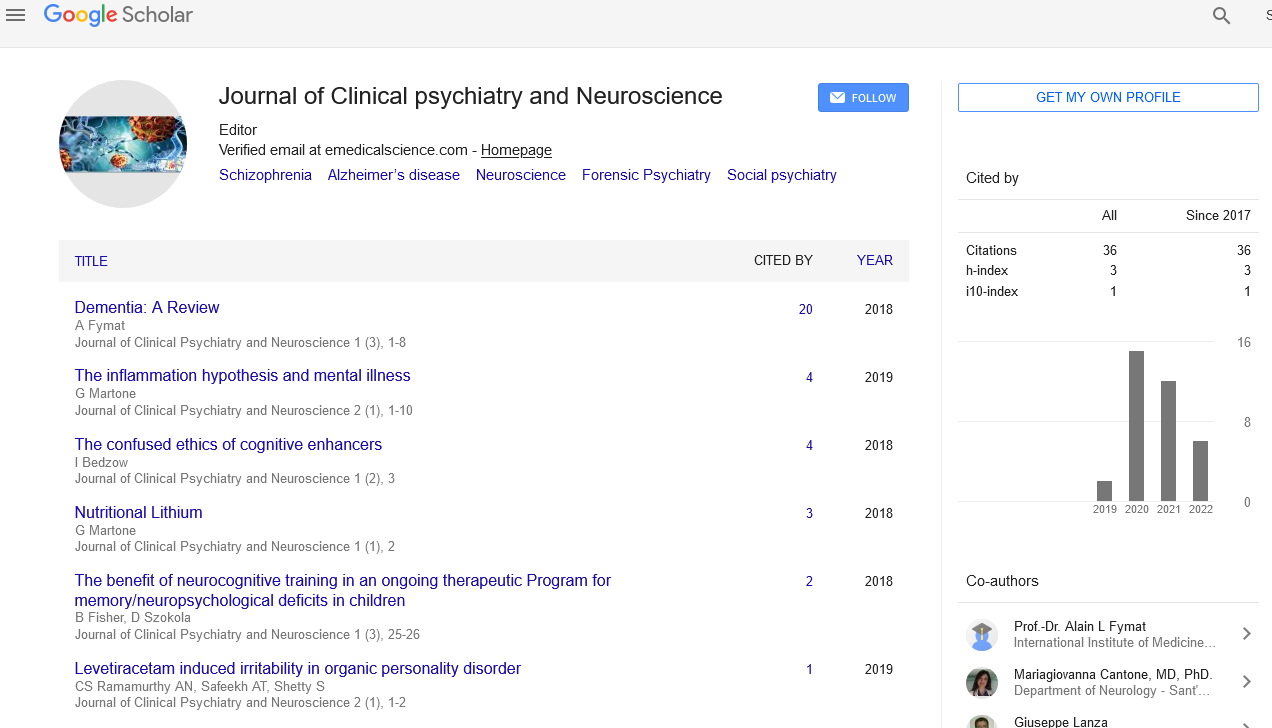Selective serotonin reuptake inhibitors usage in children and adolescents
Received: 30-May-2022, Manuscript No. PULJCPN-22-5031(M); Editor assigned: 04-Jun-2022, Pre QC No. PULJCPN-22-5031(PQ); Accepted Date: Jun 20, 2022; Reviewed: 14-Jun-2022 QC No. PULJCPN-22-5031(Q); Revised: 18-Jun-2022, Manuscript No. PULJCPN-22-5031(R); Published: 22-Jun-2022, DOI: 10.37532/ puljcpn.2022.5(3).31-32.
Citation: Dangi GS. Selective serotonin reuptake inhibitors usage in children and adolescents. J Clin Psychiatry Neurosci.2022; 5(3):31-32.
This open-access article is distributed under the terms of the Creative Commons Attribution Non-Commercial License (CC BY-NC) (http://creativecommons.org/licenses/by-nc/4.0/), which permits reuse, distribution and reproduction of the article, provided that the original work is properly cited and the reuse is restricted to noncommercial purposes. For commercial reuse, contact reprints@pulsus.com
Abstract
Depressive disorders are common in young individuals, and they are commonly neglected or undertreated. The use of antidepressants to treat depression in children and adolescents is debatable. Selective Serotonin Reuptake Inhibitors (SSRIs) were widely used in paediatric depression until cautions were published concerning their usage due to concerns that children and adolescents who had participated in trials testing the effectiveness of SSRIs were at an increased risk of self-harm. As a result, government regulatory organizations conducted detailed assessments of the studies and decided that only fluoxetine should be approved for use in children and adolescents with depressive disorders.
Key Words:
Placebo, Fluoxetine
INTRODUCTION
There have been claims and counter-claims concerning the efficacy of SSRIs and the risks associated with their usage. Concern have been made that limiting antidepressant usage may deprive young people of excellent therapies for a disorder that has significant morbidity and mortality. According to a recent study, people are reluctant to seek help because they are pessimistic about effective therapies. Furthermore, lower rates of diagnosing depressive illness may imply that doctors are hesitant to make this diagnosis, maybe due to uncertainty regarding successful treatments.
The ideal objective in the quest for successful therapies is symptom resolution (i.e. remission) and a return to normal function. Remission or functioning was inconsistently reported, not reported, or not collected in the studies included in our study. The majority of trials reported response, which translated to a decrease in symptoms but not remission. Inconsistencies in the measuring scale employed between trials, along with various definitions of response, make interpreting this outcome problematic. It demonstrates a lack of agreement on both the best assessment scale to utilize in trials and what constitutes a clinically significant improvement on these measures.
The meta-analysis revealed that there was little evidence of SSRI effectiveness. Fluoxetine was the only SSRI with consistent evidence of efficacy in improving response and depressive disorder symptoms in children and adolescents when compared to placebo. The majority of the children and adolescents who took part in the studies were not typical of those seeking therapy; they had low rates of comorbidity and were not in danger of suicide or self-harm. Those who reacted to the placebo were filtered out, increasing the likelihood of detecting a difference between placebo and medicine. Despite this, even with fluoxetine, the improvement is quite marginal. Although the rates were modest, there was evidence of an elevated risk of suicidal ideation and behavior in people on an SSRI. When deciding on treatment choices, all approaches, including psychotherapies and other antidepressants, should be evaluated. When starting therapy, the therapies with the lowest risk should be prioritized. Standard treatment, as provided by the majority of child and adolescent mental health services, may be adequate for some people to recover. Psychotherapies should also be considered. There is some evidence that a variety of psychotherapy therapies, at least in the short term, may be useful. Antidepressants may be more dangerous. Our systematic review looked at the evidence for SSRIs. A recent analysis, on the other hand, included studies comparing all kinds of antidepressant medicines against placebo. The scientists conducted a meta-regression to see if a medication class was predictive of treatment impact on the outcome response, and they concluded that there was no statistical evidence to support the hypothesis that SSRIs were more successful than tricyclic antidepressants.
Medication may be useful for certain people, especially those with more severe and complicated presentations. However, because these patients have been included in just a few trials, there is minimal data concerning the effectiveness and dangers of therapies in these subgroups. Treatment decisions should always be made in collaboration with the young person and their relatives. Given the equivocal evidence base on the effectiveness and risks of treatments, there is a special need to provide accurate information about the evidence base's limitations and elicit treatment preferences from young people and their families, allowing them to be actively involved in their treatment decision. Untreated major depression is related to morbidity and death, nevertheless, the notion that SSRIs should be used to minimize morbidity and mortality associated with major depression is not well supported. Our systematic study, along with others, has highlighted the low efficacy of SSRIs, as well as the scarcity of evidence on their efficacy in young individuals observed in clinical practice. The evidence on the risk of self-harm when using SSRIs is mixed. The hunt for effective therapies for depressive disorders in adolescents is far from done.
Meanwhile, it is critical to retain optimism and an active attitude in the treatment of depressive illnesses in children and adolescents. Depressive disorders in adolescents must be identified and aggressively handled, beginning with the least risky therapies.
Many people will respond to basic solutions. There is significant variation among young individuals who present with depressive illness, and SSRIs may be beneficial for undefined subsets of these young people. After addressing the dangers and limited evidence of success with the young person and their family, a drug trial might be considered for young people who have not responded to previous therapies or those with a particularly severe or debilitating condition.





